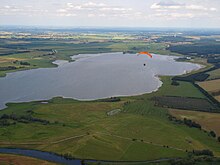Gülper See
| Gülper See | ||
|---|---|---|

|
||
| Geographical location | 70 km west of Berlin | |
| Tributaries | Rhin | |
| Drain | Rhin | |
| Location close to the shore | Rhinow , Rathenow | |
| Data | ||
| Coordinates | 52 ° 44 '23 " N , 12 ° 15' 18" E | |
|
|
||
| Altitude above sea level | 23.6 m above sea level NHN | |
| surface | 6.6 km² | |
| length | 3.5 km | |
| width | 1.5 km | |
| Maximum depth | 3 m | |
| Middle deep | 1.5 m | |
The Gülper See in the municipality of Havelaue is about 70 kilometers west of Berlin on the western edge of Brandenburg , in the northwest of the Havelland district between the villages of Gülpe , Prietzen , Kietz and Strodehne . It is about 660 hectares (3.5 kilometers in east-west and 1.5 kilometers in north-south direction) and is 23.6 m above sea level. NHN . In an east-west direction it is traversed by the Rhin, which flows directly below the lake into the Gülper Havel , in whose floodplain the lake is located. It has been under nature protection since 1967.
Origin and characteristics
The Gülper See is a glacial lake, i. In other words, it emerged as a result of the Vistula Ice Age from a basin washed out by glacier meltwater at the confluence of the Eberswalder and Berlin glacial valley . Its depth is about one to two, in the area of the drain also up to three meters. 25 years ago it was a clear water lake rich in aquatic plants, which has since developed into a cloudy lake with a strong development of phytoplankton ("algae bloom") and visibility under fifty centimeters in the summer months due to increased nutrient supply .
Large deposits of muddy sediments ( Gyttja , semi-sludge) formed mainly in the west, north and northeast, where wide belts of reeds line the lake. The water level of the Elbe and its backflow into the Havel have a decisive influence on the hydrological conditions in the area. Due to the low elevation of the area above the mean water level of the Havel and because of the low gradient of the Havel and Rhin, there are long-lasting floods in the areas around the Gülper See. The outflow from and thus the water level in the Gülper See is mainly regulated by the Gahlberg needle weir . A second regulating weir is located in a former lock basin near the Gülpe barge lock in a ditch that runs southwest to the Gülper Havel. In the south-east and south, the flat banks merge into extensively grazed grassland and grassland vegetation. The surrounding area is mainly made up of wet meadows , occasionally also fields and wooded areas (willows and poplars, in the south pine forests); In contrast to other lakes in the region, the Gülper See has a very "open" character.
natural reserve
The lake forms the core of the 970 hectare nature reserve (NSG) Gülper See, which has existed since 1967, at that time much smaller. The NSG is in turn part of the Westhavelland Nature Park , the largest protected area in Brandenburg, which is also known as a star park because of its natural night sky . The outstanding importance as a breeding or resting area for Limikolen , geese, ducks and cranes led (together with the Lower Havelniederung) to the classification as Wetlands of International Importance (FIB) within the framework of the Ramsar Convention . On August 5, 2009, the Gülper See was transferred to the NABU Foundation for National Natural Heritage together with other areas .
The Gülper See is a resting place for white - fronted geese and bean geese , several 10,000 of which are here in spring and autumn. It is also becoming more and more important as a sleeping place for cranes - in October 2006, around 10,000 of these large birds were counted. The spectacle of the cranes trumpeting loudly towards the lake from all sides at dusk increasingly attracts tourists to the area.
Other z. Sometimes rare and endangered bird species breed or rest around the Gülper See, such as whooper swans , many species of ducks and limicoles, cormorants , sea and ospreys , red and black kites , marsh harriers , bitterns , gray bugs , whinchat , pouches and bearded tits . A floristic peculiarity is the complete series of the fen - Verlandungs - companies west and east of the lake.
See also
Web links
- Gülper See - bird paradise in the Westhavelland . NABU Foundation for National Natural Heritage, accessed February 9, 2016
- Bird migration at Gülper See , Westhavelland Nature Park, accessed on February 9, 2016
- Bird watching around the Gülper See
Individual evidence
- ↑ Rene Wernitz: wooden needles and bridge remain. In: MOZ.de . July 12, 2013, accessed August 24, 2020 .
- ↑ Platzeck welcomed land transferred to NABU Foundation press release State Land Brandenburg from August 5, 2009
- ↑ Gülper See - Bird Eldorado in Westhavelland . NABU Foundation for National Natural Heritage, accessed February 9, 2016.


